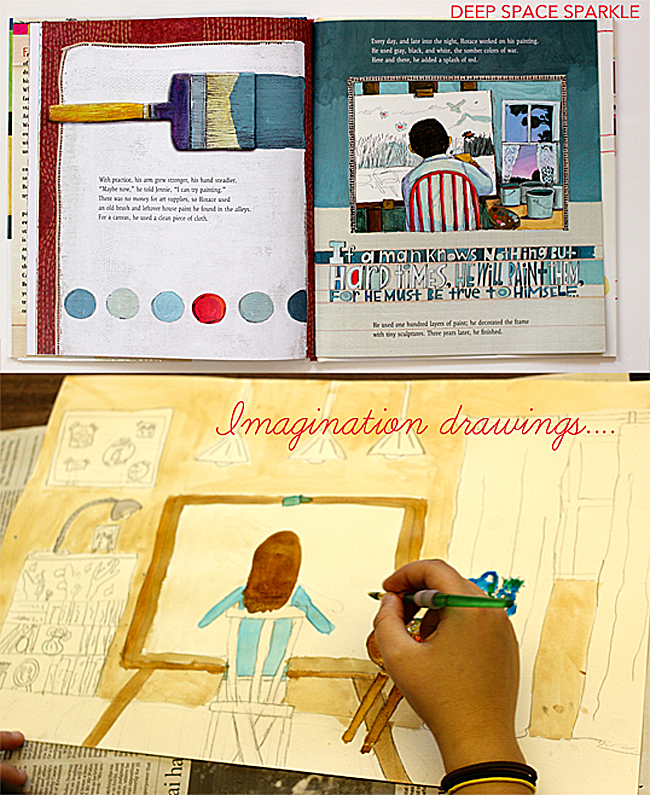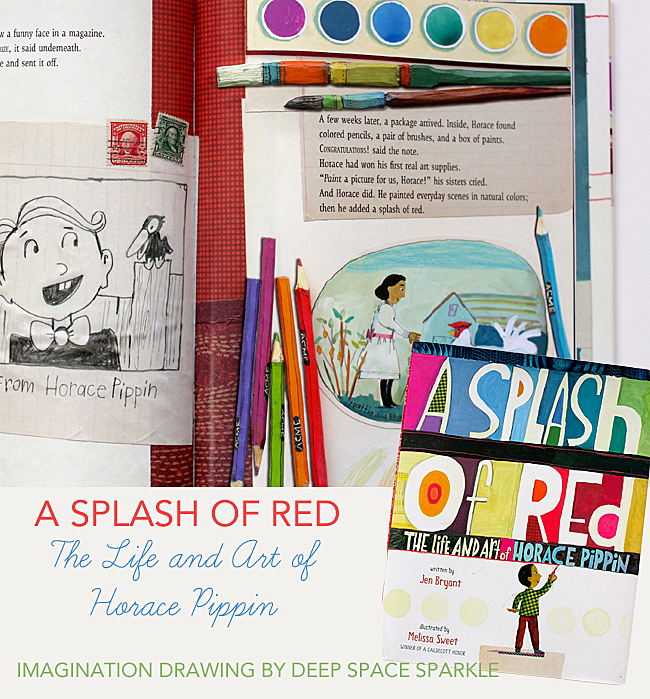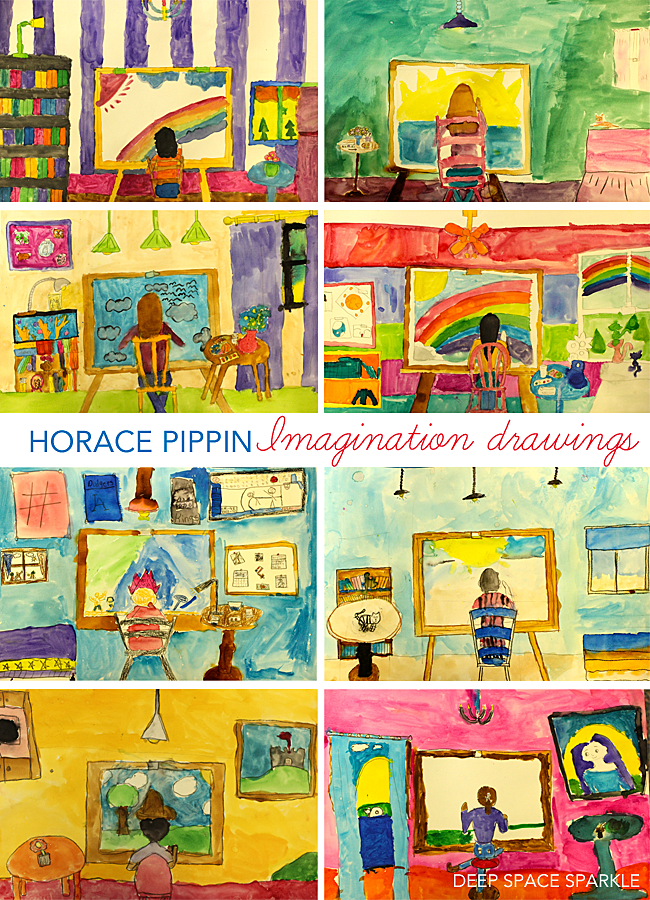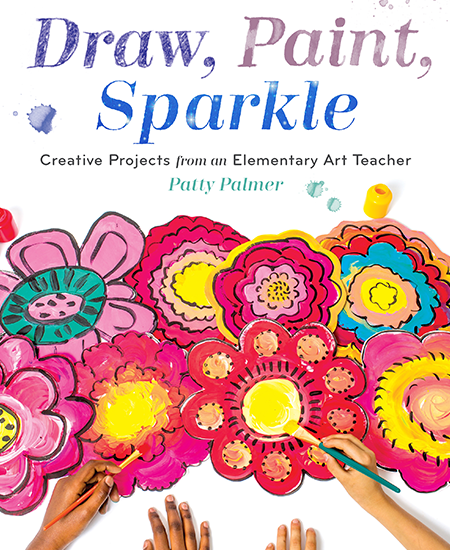A Splash of Red: The Life and Art of Horace Pippin is a beautifully illustrated and written book about American self-taught painter, Horace Pippin. It’s what I call a perfect “art class” book as the story is riveting enough for older readers (in my case, 5th graders) and the illustrations are simply inspiring.
My goal with this lesson was to teach my 5th graders about a relatively unknown American painter and how every artist’s journey is different. There is a spread in the book that shows Horace painting in his studio. He paints what he knows, sees and recalls. He uses his imagination and likes to add a touch of red.
This is the page that gave me the inspiration for this art lesson….

My questions to my students were:
- What would you paint on your easel?
- What does your room look like?
- What colors would you use?
- What would appear outside your window?
I gave each student a piece of 12″ x 18″ 90-lb watercolor paper, a pencil, a tray of watercolor paints, colored pencils, a brush and some water. The students shared a 4″ x 6″ cardboard template to draw the easel: the main subject in the composition. We did a guided drawing for the easel, chair and artist.
On the whiteboard I drew a large rectangle to mimic the watercolor paper then drew a small rectangle inside to mimic the easel. I demonstrated a few options for chair which could be drawn first. Then showed the kids how to draw a back-facing person sitting in the chair.
Here are some tips:
- Encourage the kids to draw as large as possible. When drawing with pencils, 95% of children will draw very small even if given a large piece of paper. This is why I rarely use pencils but in this project, I wanted to give them a try.
- I used 12″ x 18″ paper but a better choice would be a 9″ x 12″ paper. The large paper took a very long time for most children to fill. This was exacerbated by the use of pencils. Pencils=Perfectionism.
- Use a larger easel template so that more of the paper can be filled, thus encouraging larger shapes to paint.
Drawing the room:
Talk about the various items that are commonly seen in bedrooms like beds, dressers, curtains, light fixtures, etc. Then ask the students to fill up the paper with these items. Many children will forget rules of perspective and if you try and teach perspective here, it is time-consuming. Trust me! I felt as though the students were successful if they were able to draw large enough.
After all the details were drawn with pencils, I encouraged both colored pencils and watercolor paints to be used to add color.
This project can take a very long time to do and in the end, it wasn’t a great project for my art program because it consumed a little less than a third of the classes I have with my 5th graders. You will find that many children will obsess over the tiny objects in the room and ignore the bigger pieces like walls, floors and beds. That’s just a developmental thing.
If I were to do this lesson again, I would use 9″ x 12″ paper and focus only on the easel and the artist. That way, the images would be larger, more focused and still would allow a great deal of imagination.
Have you done an imagination painting before using pencils? What are your tips for getting students to draw large? Share your experiences in the comments below….
In the end, there were some very proud fifth grade artists!










fantastic resource! Thank you….can’t wait to read the book
oh lovely. this book is now on my wish list.
I have found the same problems to be true with pencil drawings: the students make the details too small and take forever! So we usually go right to the paint. I have many examples, large posters, of Horace Pippin paintings and we usually look at them for Feb: African American Art Month. I love the book, tho, and the idea of painting the students’ room. As Picasso said, a snapshot of an artist’s studio, or room, is like a self-portrait of the artist.
Yup. I knew the “risks” when I began this project but I thought I could encourage the larger drawing idea. Nope! Pencils, no matter how you use them, result in small drawings in elementary school. So funny how that is!
What gorgeous artwork! I’m so intrigued by your comments about pencils = perfectionism and that kids don’t draw larger pictures when they have larger paper. I don’t work with kids but have noticed the same tendencies in myself when I’m working on designs–I have to really fight to make things larger when I start with a pencil.
Really, though, when I saw you’re in Goleta I had to say hello. I grew up in Santa Barbara and Isla Vista, though I’m now on the other coast :-).
Thank you, I have just been looking for info about
this subject for a long time and yours is the greatest I’ve
came upon so far. However, what about the bottom line?
Are you positive about the supply?
These came out really well. I have this book also, but I haven’t used it yet. I love your play on that illustration. I may have to introduce that idea to my older students. I agree about the pencil… I find it much more freeing to make the kids use markers, oil pastels, or chalk pastels to sketch their ideas. They always push down so hard with the pencil and then it’s a headache to erase (which is a whole other ball of wax).
Patty–This too-brief comment does not do your post justice . . . but I just wanted to let you know how delighted I am to see this, how impressed I am with your teaching ideas, and how amazing the childrens’ artwork (generated from that) really is! I have shared it on my Facebook page this morning (with full credit to you and thanks to Vicki Palmquist over at Winding Oak who shared it with me) and have encouraged others to pass it along. Again, many thanks for what you do!
Thank you so much, Jen! It’s a wonderful book, both text and art. A perfect book for my art room~
I teach art classes through the local parks & rec program, and I used your lesson plan with a small group of 7-11 year olds in an advanced drawing class that was 1 1/2 hours long. I tend to get kids that are really excited about art and they enjoy the longer sessions because they usually feel rushed at school. I changed the project a little bit and I wanted to share my variation with you.
We took a small sheet of paper and traced it on our larger sheet. The traced rectangle was basically a placeholder for a blank canvas for them to imagine on their drawing table or easel. Their homework was to create anything they wanted on that small piece of paper (a mini masterpiece) and bring it back the following week.
During class they drew their dream studio on the large sheet. Because my classes are small, I can let them talk freely during class and they were all sharing ideas about what to put in their rooms. It was a really animated conversation. We took a break mid-way through so everyone could get up and walk around to see each other’s work and I encouraged the “stealing” of ideas. They had so much fun and we ended up with rooms full of artwork, awards, pets, mini-fridges, and music players.
I put out markers, crayons, color pencils, and watercolor and let them choose if they added color and which medium to use.
When they brought their work back the next week, I used an exacto to cut little slits on their easels/desks and to cut along their silhouettes if they drew themselves in front of the easel/desk. I used the slits and a temporary glue dot to hold their masterpieces in their new studios. The kids loved that they could change out the piece of paper later on when they have a new masterpiece. I’ll try to post some photos somewhere so you can check them out.
Thank you so much for providing this resource! It’s given me the confidence to tackle more complicated projects with my students.
what do you think about the painting and the person painted and everything else in a pencil drawing
I loved your detailed lesson
Can you email this to me? This lesson
This is wonderful. Very good direction and so much valuable learning going on !1